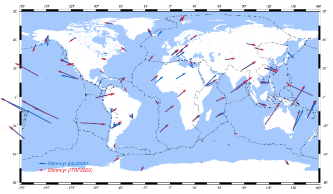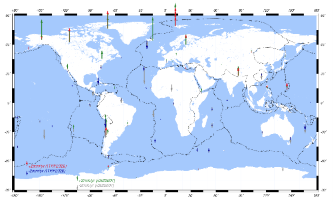Cumulative solution
Since the IDS contribution to the realization of the ITRF2014, the IDS Combination Center (CC) routinely (every three months) computes a DORIS position and velocity cumulative solution from the latest IDS combined series. The cumulative solution provides the usual/classical estimates: station positions and velocities at a mean epoch.
All the details on the elaboration of the IDS cumulative solutions aligned to ITRF2014 can be found in Moreaux et al. (2016).
Figure - ids22d01 and ITRF2020 velocities with formal error smaller than 2.5 mm/yr (left: horizontal; right: vertical).
Releases aligned to ITRF2020:
- January 2023 – version #1 – Time span: 1993.0-2022.0 – ids22d01 - Product available at CDDIS (HTTPS authenticated) and IGN (FTP link) Validation results
See the residuals on the IDS webservice
Releases aligned to ITRF2014:
- August 2020 – version #5 – Time span: 1993.0-2020.0 - ids20d05 - Product available at CDDIS and IGN - Validation results - Residuals
- September 2019 – version #4 – Time span: 1993.0-2019.0 - ids19d04 - Product available at CDDIS and IGN - Validation results - Residuals
- June 2018 – version #3 – Time span: 1993.0-2018.0 - ids18d03 - Product available at CDDIS and IGN - Validation results - Residuals
- October 2017 – version #2 – Time span: 1993.0-2017.0 - ids17d02 - Product available at CDDIS and IGN - Validation results - Residuals
- March 2017 – version #1 – Time span: 1993.0-2016.0 - ids17d01 - Product available at CDDIS and IGN - Validation results - Residuals
Input data:
- Weekly SINEX files from the latest IDS combined series.
- Station discontinuities (online file).
- Tie vectors (online file).
Output files:
- Cumulative solution in SINEX format.
- Station position residuals (online plots).
- Tie discrepancies (estimated – measured ties; online plot).
Citation:
Moreaux, G., Lemoine, F.G., Argus, D.F., Santamaría-Gómez, A., Willis, P., Soudarin, L., Gravelle, M., and Ferrage, P., 2016. Horizontal and vertical velocities derived from the IDS contribution to ITRF2014, and comparisons with geophysical models, Geophysical Journal International, 207(1), 209-227, doi:10.1093/gji/ggw265


